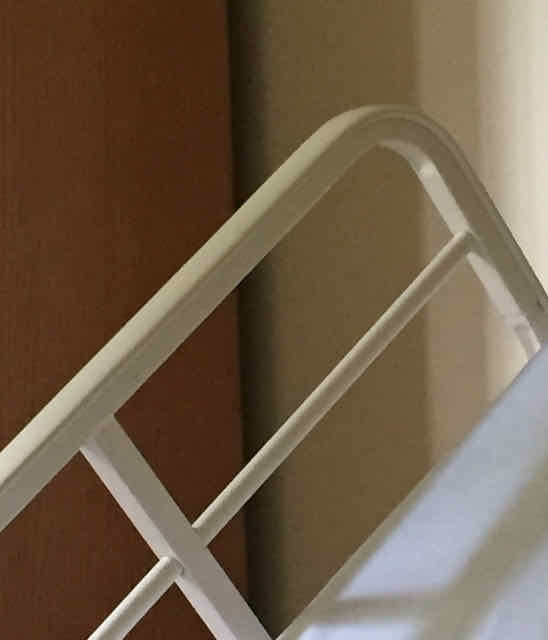Getting Old: It Could Happen to You

Residents slump over wheelchair armrests in the overly air-conditioned “living room.” The television blasts a folk tune hijacked for a diabetes drug. Off to the right and left, like airport runways, lights over patient rooms flank the corridors, because the staff has turned off the call bells. A woman alone in her room cries, “Help me.”
Recently, as I recalled these firsthand observations of the nursing home where my father spent his last eleven days, I realized that if something else doesn’t get me first, they could describe my future “home.”
Sure, we can buy long-term care policies, but those will only make it easier for us to afford care, not ensure humane conditions.
Advocating now for senior citizens will increase the possibility that when it’s our turn, we will receive quality care and respect.
You might think the conditions I described above occur only in state-run, low-budget facilities. In reality, they can happen anywhere, including the nursing home where I placed my father—a premier facility in our area with a five-digit monthly price tag. He was self-pay, because that home wouldn’t take him if they had to fool with Medicare. It wouldn’t make financial sense for this “non-profit” to invest the upfront cost on someone who wouldn’t be there very long.
Nowadays, we’re supposed to think that institutions can take care of our loved ones better than we can. We don’t even know how to die anymore. When my father entered the nursing home, I arranged hospice care right away thinking this was best. In my father’s case, the fact that he was in a nursing home created a diffusion of responsibility between the nursing home and hospice staffs. No one took charge. Each deferred to the other. Promises were made but not kept. How I wish we had kept him at home.
The median age in America, which is 38 now, is expected to rise to 43 by 2060. Life expectancy was 70 in 1968 and almost 80 now. These numbers will continue to rise.
Baby boomers are putting a strain on Social Security and public health services. More money is going out than coming in. The supply and demand of healthcare is lopsided. There’s a critical shortage of home health aides and nurses.
As overwhelming as the present situation is, if we continue to let these factors adversely affect care of our elderly, by the time the last baby boomer has died, the manner in which we have treated them will become the standard for those who follow.
Even if we have many years before we have to worry about finding day-to-day help for ourselves, what will eldercare be like then? The time is now to make sure there are protections in place for the elderly, to give them the best care possible. For them—and in our own best interest.
Folks living in long-term care facilities were once leaders, teachers, scientists, business people, homemakers. They are still the same people they once were. It’s just their bodies—and sometimes their minds—that are fading away.
Consider this:
- Keep your loved one at home, if possible. Home healthcare services are expensive but preferable to institutional care.
- Advocate for governmental support of families that care for loved ones themselves both financially and through respite services.
- Advocate for the elderly and don’t be afraid to speak up for those who can’t.
- If your loved one is in a facility, closely monitor their care. And visit as often as possible.
- Educate yourself about the aging and dying process.
There are many resources for planning and managing care, plus advocating for our older citizens.
- LeadingAge has 5,700 member organizations that provide services such as adult day care, home health, community services, senior housing, assisted living residences, and nursing homes.
- California Activists for Nursing Home Reform (CANHR) focuses on direct advocacy, community education, legislation, and litigation. It also seeks to create strong advocacy for long-term care reform and humane alternatives to institutionalization.
- Long Term Care Community Coalition (LTCCC) was founded in the late 1970’s after a string of scandals in New York State involving long-term care facilities. LTCCC works with the government to improve long-term care in the New York State and the country.
- The National Consumer Voice for Quality Long-Term Care (NCCNHR) addresses inadequate staffing in nursing homes, poor working conditions, maintenance of residents’ rights, empowerment of residents, and support for family members.
- The Centers for Medicare and Medicaid Services (CMS) offers a nursing home compare tool for selecting the right facility, a list of nursing home residents’ rights, and other tools for researching and understanding nursing homes and long-term care facilities.
- The Administration on Aging (AOA) helps elderly individuals “maintain their dignity and independence in their homes and communities through comprehensive, coordinated, and cost effective systems of long-term care, and livable communities across the U.S.”
- Each of the fifty states, Puerto Rico, and the District of Columbia have at least one agency devoted to nursing homes. These agencies handle certification and oversight, eldercare and advocacy for the elderly. They may be able to assist you when you are deciding which facility best meets your loved one’s needs. They might also be able to help when trying to resolve problems with care. These agencies are usually a division of the state’s Department of Social Services or Department of Health.




Thanks for providing helpful info on this important subject.